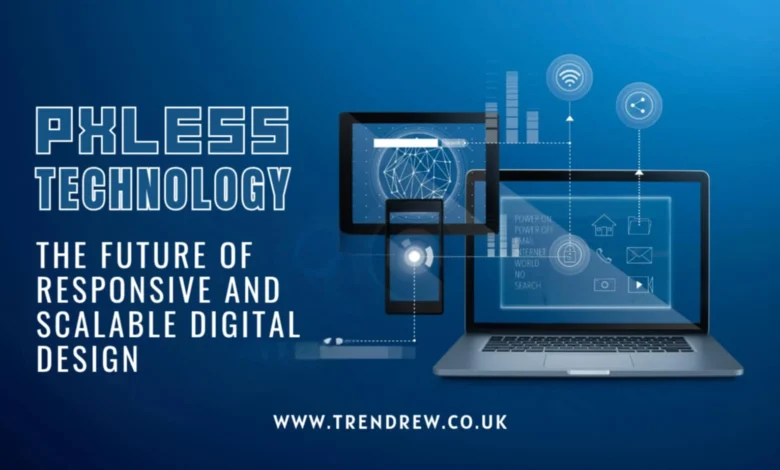Pxless Technology: The Future of Responsive and Scalable Digital Design

In the rapidly evolving world of digital design and technology, where new devices and display formats emerge almost every day, the traditional approach of designing with fixed pixels is becoming outdated. Designers and developers are now seeking ways to make websites, applications, and interfaces more adaptive and user-friendly. Enter Pxless — a revolutionary design philosophy that challenges the limits of pixel-based thinking and introduces a new era of responsive, fluid, and scalable digital experiences.
Pxless is not merely a technical adjustment; it’s a mindset shift. It promotes designs that can adapt naturally to any screen or device without sacrificing usability, accessibility, or performance. By moving beyond rigid measurements, Pxless paves the way for a more efficient, inclusive, and future-proof digital world.
What Is Pxless?
At its essence, Pxless means “less dependent on pixels.” It’s a design approach that eliminates the dominance of fixed pixel values (like 100px or 16px) and replaces them with relative, scalable, and dynamic units such as percentages (%), rem, em, vw (viewport width), and vh (viewport height).
Pixels used to be the foundation of web and app design—each button, text, or image defined with exact measurements. However, with today’s vast range of devices—smartphones, tablets, desktops, smart TVs, and wearables—this rigid system no longer holds up. Pxless design embraces fluidity over rigidity, enabling digital elements to resize and reorganize according to the screen or user preferences.
The Evolution Behind the Pxless Concept
In the early days of web design, fixed-pixel layouts were ideal because most users viewed websites on similar monitors. But as the technology landscape diversified, designers began to face challenges:
-
Websites looked perfect on desktop screens but broke on smaller devices.
-
Fonts became unreadable when users zoomed in.
-
Accessibility suffered for users with vision impairments.
Responsive design attempted to solve these problems, but many developers still relied on pixel-based measurements within their “responsive” layouts. Pxless takes responsiveness a step further — making designs truly fluid and adaptable by default, not just through conditional breakpoints.
Core Principles of Pxless Design
To understand the Pxless philosophy, it’s essential to look at its foundational principles:
Fluidity
Every element adjusts proportionally to its parent container or viewport, ensuring that the layout maintains balance across screen sizes.
Scalability
Text, images, and buttons scale smoothly without distortion, ensuring usability on both large monitors and small mobile devices.
Accessibility
Users with visual or physical challenges can customize their viewing experience—adjusting font sizes or zoom levels—without breaking the interface layout.
Efficiency
Designers spend less time rewriting layouts for each screen size, as Pxless naturally adapts to various devices.
Future-Readiness
As technology evolves, Pxless ensures that digital products remain compatible with emerging devices such as foldable screens, AR/VR interfaces, and smart wearables.
Why Pxless Matters in Modern Digital Design
The rise of Pxless isn’t just a design trend—it’s a practical solution to the modern problem of digital diversity. Today’s users access websites and apps on an incredible variety of devices, each with unique resolutions, orientations, and dimensions. A pixel-locked design can’t keep up with this complexity.
Pxless ensures that every user gets an optimal, consistent experience regardless of their device. Beyond that, Pxless design also enhances performance and accessibility, both of which are increasingly important for compliance, brand reputation, and user satisfaction.
Building Blocks of Pxless: The Technical Foundation
Implementing Pxless design involves replacing absolute pixel units with flexible, responsive measurements. Here’s how:
-
Percentages (%): Define element dimensions relative to the parent container.
-
EM/REM Units: Scale typography and spacing based on root or parent font sizes, maintaining proportionality.
-
Viewport Units (vw/vh): Adjust layout based on the visible portion of the user’s screen.
-
Clamp() Function: Create responsive scaling ranges for font sizes and elements (e.g.,
font-size: clamp(1rem, 2vw, 2rem);).
This approach ensures seamless scaling without needing hundreds of media queries or layout overrides.
Modern Layout Systems That Empower Pxless
Pxless design thrives with modern CSS tools like Flexbox and CSS Grid:
-
Flexbox: Ideal for aligning items dynamically within containers. It lets buttons, menus, and cards automatically adjust size based on available space.
-
CSS Grid: Perfect for complex page layouts. Using fractional units (like
1fr, 2fr), designers can create scalable structures without fixed widths.
Together, these systems eliminate pixel-dependency, allowing the browser to intelligently handle alignment and spacing across devices.
Applications of Pxless Across Digital Platforms
Web Design
Pxless revolutionizes how websites respond to varying screen sizes. Instead of rigid widths, layouts adapt automatically using fluid measurements. This eliminates inconsistencies and creates a smoother browsing experience on all devices.
Mobile Apps
With countless mobile screen sizes on the market, Pxless ensures uniformity without manual tweaking. Apps look polished and function seamlessly, reducing development time and maintenance costs.
Digital Branding
Brand assets like logos and typography scale elegantly across digital touchpoints. Pxless helps maintain brand consistency across all display environments—social media, web, and mobile alike.
E-Commerce
Online stores benefit immensely from Pxless design. Product images, descriptions, and checkout buttons remain accessible and visually balanced across screens, improving conversion rates and reducing cart abandonment.
Accessibility-Driven Platforms
Government portals, educational institutions, and healthcare websites increasingly rely on Pxless for compliance. Scalable layouts allow users with vision challenges to zoom or resize without losing functionality.
How Pxless Improves SEO and Performance
Google’s algorithms prioritize mobile-friendly and accessible websites. Pxless design directly supports both by improving:
-
Mobile Responsiveness: Adaptive layouts look great on all screens, supporting Google’s mobile-first indexing.
-
Core Web Vitals: Smooth transitions and reduced layout shifts improve performance metrics like “CLS” and “LCP.”
-
User Engagement: Fluid designs keep visitors on-site longer, lowering bounce rates and boosting rankings.
By adopting Pxless, businesses not only enhance usability but also improve search visibility and conversion potential.
Challenges of Adopting Pxless
Despite its benefits, shifting to Pxless design can present some obstacles:
-
Learning Curve: Designers used to pixel-perfect precision may find it difficult to adapt to a flexible mindset.
-
Tool Limitations: Many popular design tools are still built around fixed artboards.
-
Testing Requirements: Pxless designs require more testing across multiple devices and zoom levels.
-
Client Expectations: Some clients prefer exact mockups, making it challenging to sell fluid design concepts.
Overcoming these challenges involves clear communication, consistent testing, and a collaborative workflow between designers and developers.
Best Practices for Implementing Pxless Design
-
Start with a Fluid Base: Use a root font size in rem to ensure global scalability.
-
Avoid Fixed Widths: Replace pixel widths with percentages or fractional units.
-
Use clamp() for Typography: Let text grow and shrink within logical limits.
-
Test Across Devices: Simulate multiple resolutions and zoom levels using developer tools.
-
Embrace Simplicity: The goal is not to control every detail but to maintain visual harmony.
The Future of Pxless
As the number of devices continues to grow, Pxless will become the default standard for digital design. Tools, frameworks, and design systems are evolving to integrate Pxless logic natively, making it easier for teams to adopt. Its emphasis on flexibility and accessibility aligns perfectly with global digital transformation trends.
In the near future, Pxless could serve as the foundation for adaptive design frameworks that automatically adjust based on context, environment, or even user behavior.
Conclusion
Pxless represents more than a technical improvement—it symbolizes a paradigm shift in digital design. By moving away from rigid pixels toward scalable, fluid, and adaptable systems, designers and developers can create interfaces that are not only visually stunning but also inclusive, efficient, and ready for the future.
Whether you’re a designer seeking creative freedom, a developer aiming for better performance, or a business owner wanting a more consistent online presence, Pxless offers a clear path forward. It’s time to design beyond pixels—to design for people, devices, and possibilities.
FAQs
1. What does Pxless mean?
Pxless refers to a design approach that minimizes the use of fixed pixel measurements, focusing instead on flexible, scalable units that adapt to different devices.
2. Why is Pxless important?
It ensures that websites and apps remain accessible, readable, and functional across all screen sizes and resolutions, enhancing user experience.
3. What units replace pixels in Pxless design?
Designers use %, em, rem, vw, vh, and clamp() to create fluid and responsive layouts.
4. How does Pxless affect SEO?
Pxless improves site speed, responsiveness, and accessibility—all factors that boost search engine rankings.
5. Is Pxless difficult to implement?
It requires a shift in design mindset but is easy to adopt with modern CSS systems like Flexbox and Grid. Over time, Pxless simplifies workflows and reduces maintenance costs.



